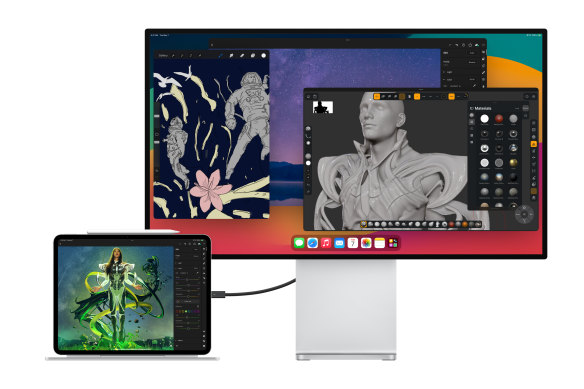- Analysis
- Technology
- Gadgets
With a series of firsts, Apple’s new iPad launch points to changes ahead
By Tim Biggs
Apple centralised much of its UK staff and operations into an enormous 500,000-square-foot, six-storey space within a restored 1930s power station in central London’s Battersea about a year ago.
The breathtaking campus – which has swapped coal generation for renewable energy, massive boilers and labourers for glass, clean brick, indoor plants and cheekily named meeting rooms – last week hosted its first large-scale press event.
However, it was far from the only first of the day. It was also the first time Apple had held a hardware reveal like this at all.

Apple’s London headquarters takes up the bulk of a restored power station, which also holds shops and restaurants.
Rather than an in-person presentation at its headquarters in Cupertino, California, new iPads were revealed in London via a prerecorded address streamed worldwide, including other press at events across North America, Europe and Asia.
Each event had new devices to play with, as well as members of Apple’s US leadership team, engineers and product experts.
It is unclear if this decentralised approach, which likely makes it easier to accommodate a growing cohort of global technology and lifestyle influencers, as well as the traditional press, would work for the all-important new iPhone reveals later this year. However, it certainly gives Apple more leeway to target its marketing messages and avoid bringing thousands of foreign reporters to Cupertino.
It was also the first time Apple has debuted a new generation of its M-series system-on-a-chip packages in a device that is not a Mac.
So, what does it mean that the M4 – which comes only half a year after the reveal of the M3 – is appearing in an iPad first?
In some sense, it might not mean much. Listening to Apple’s hardware engineering lead John Ternus, it sounds like meeting the power, display and thinness goals for the new iPad Pro simply demanded silicon that the M3 family doesn’t allow, and thus it was included in a new chip design.
Although nobody at Apple would be caught openly speculating about unannounced devices, one has to assume the M4 isn’t purely a one-and-done that will appear only in this iPad. For starters, the M4 carries not only the requisite leaps in efficiency and a new display engine built to drive the iPad but also a phenomenally improved neural capability to power artificial intelligence processes.
Onstage, Apple’s marketing boss Greg Joswiak was keen to state that the M4 made the iPad Pro more AI-capable than any Intel-powered AI PC on the market, which you could interpret as sowing the seeds for a future M4-powered MacBook.

The latest iPad Pro has a Thunderbolt USB-C connector to plug into external storage, accessories or external monitors.
Currently, all the talk about AI on M4 is about accelerating processes in apps ranging from music creation and video production to architectural room-scanning and sports-related skeleton tracking.
However, the wider tech industry is more interested in generative text, code writing, and multimodal chatbots—a pool into which Apple has yet to jump. A powerful AI chip that lets you run privately on-device without resorting to cloud computing could make for a good springboard.
As for the iPad Pro itself, it is the first Apple tablet with an OLED screen and the first device to fuse two OLEDs together in a technique Apple says was required to achieve its impressive brightness on such an expansive, battery-powered device.
It is also the first iPad to discard physical SIM cards – the cellular models are e-SIM only – and the first to offer nano texture glass as an option for customers who need absolute colour control.
This all seems to add up to a device that lives up to its moniker; Apple wants the iPad Pro to be a tool for professionals.
With quality colour reproduction and consistency, all the power needed to run high-end visual modelling or AI tasks, and access to the App Store for any number of editing or creation suites, it’s not a straight-up replacement for a laptop but an alternative to one in certain workflows.
Apple doesn’t see it as merely a tool for artists and architects but also for Hollywood film production, industrial design, and even medical use.
Last week’s event revealed the first 13-inch iPad outside the Pro line. The iPad Air finds itself in a funny place in terms of nomenclature now that the Pro is thinner and lighter, but its function as the mid-range Apple tablet has never been clearer.
Technology and features from past and present Pro models are filtered down to make something still expensive and powerful – with the M2 chip seen in the previous Pros – but tuned for consumers.
The extra real estate of the larger screen is striking, and it is easy to see why anyone who uses their tablet with a stylus for art or note-taking might be interested. It also opens the door for the education market – another key sector for the iPad aside from creative professionals – to use larger screens without forking out extra cash for Pro models.
Finally, this is the first time the iPad lineup has lacked an old-school model with home buttons and headphone jacks.
The iPad mini – unchanged and mostly unacknowledged last week – is still hanging in there, but the Gen 9 iPad is gone. That makes the Gen 10 (now simply referred to as “iPad”) the entry-level model, and it’s well-placed to fill that role with its full-screen display, powerful chip and Pencil compatibility.
Even more than the upgraded Air, the lowering of the price of this tablet to $600 could have the biggest impact on the education sector and students.
The author travelled to London as a guest of Apple.
Get news and reviews on technology, gadgets and gaming in our Technology newsletter every Friday. Sign up here.